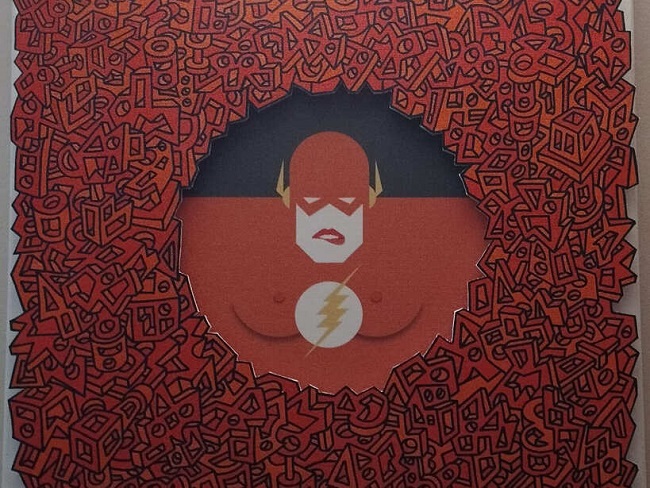Prendersi in giro sapendo cogliere sia il lato più giocoso sia quello più intenso della società attuale è una caratteristica comune a pochi artisti, perché spesso l’arte viene vista e vissuta come un modo per lasciar fuoriuscire tutte le tensioni emozionali che l’autore di un’opera non sa comunicare in maniera differente; tuttavia vi sono stati, e vi sono ancora, dei creativi che hanno saputo far sentire la propria voce anche senza mostrare subito la propria capacità di approfondimento bensì attraendo lo sguardo dell’osservatore con un linguaggio apparentemente diretto e divertente che solo in un secondo momento conduce a una riflessione più acuta del messaggio che l’artista desiderava lasciare. Il protagonista di oggi sceglie una cifra stilistica singolare e personale attraverso cui esplora tutto ciò che appartiene alla contemporaneità.
Dopo aver rotto tutti gli schemi dell’arte tradizionale, dopo aver esplorato la mente e l’inconscio, dopo aver prima perduto e poi successivamente recuperato il contatto con l’emozione, gli artisti della metà degli anni Cinquanta, in particolar modo quelli statunitensi, cominciarono ad avvertire la necessità di trovare un linguaggio inedito che fosse più affine e comprensibile dalla nuova borghesia emergente che pur non avendo avuto una specifica formazione culturale volta a sviluppare una sensibilità nei confronti dell’arte, aveva però la capacità economica di poter acquistare delle opere, seppure non di altissimo valore. Fu quello il momento in cui nacque la Pop Art, guidata dall’incredibile intuito di Andy Warhol che trasformò in arte beni comuni di consumo, così come le immagini del cinema e della politica che facevano parte della quotidianità della maggior parte delle persone; la pittura cambiò completamente aspetto, le stampe, la serigrafia, il segno grafico, divennero parte integrante del linguaggio espressivo di Roy Liechtenstein, di Tom Wesselmann e delle incursioni Street Art di Keith Haring. L’immediatezza delle loro immagini, la semplicità espressiva poteva conquistare in maniera diretta proprio quella classe media che stava cominciando ad acquisire rilevanza nella società e soprattutto aveva bisogno di riconoscersi negli oggetti, e di conseguenza dei pezzi d’arte, che sceglievano di avere in casa. Trovare simboli conosciuti, far innamorare il pubblico di un’immagine di facile comprensione che non richiedesse una formazione troppo intellettuale fu la formula vincente di quella generazione di artisti in grado di scrivere una pagina nuova nell’arte moderna. Laddove Roy Liechtenstein si legò al mondo dei fumetti, mostrando quanto la grafica, seppur eseguita a olio su tela, potesse avere un impatto interessante per raggiungere il fruitore e quanto il suono onomatopeico delle strisce dei cartoon desse un tocco ironico, Tom Wesselmann scelse l’irriverenza nei confronti dell’arte del passato, delle abitudini quotidiane del presente e delle nuove e vecchie debolezze dell’uomo e della donna, mescolando pittura e scultura per infondere un senso di bizzarra realtà. E infine Keith Haring, il vero e proprio genio del tratto grafico attraverso i suoi Radiant Boys che creavano una sorta di reticolo umano con cui l’artista rappresentava la realtà, sensibilizzando e denunciando i disagi e le difficoltà di un’omosessualità ancora non pienamente accettata. L’artista lombardo di origini e romagnolo di adozione Roberto Zucchi, in arte Byro, si ispira ai reticolati grafici di Haring che però nel suo caso non rappresentano una stilizzazione dell’uomo bensì descrivono figure geometriche o lettere che al loro interno hanno altre figure geometriche o lettere, quasi a suggerire le infinite possibilità e combinazioni che appartengono innegabilmente alla poliedricità della realtà.
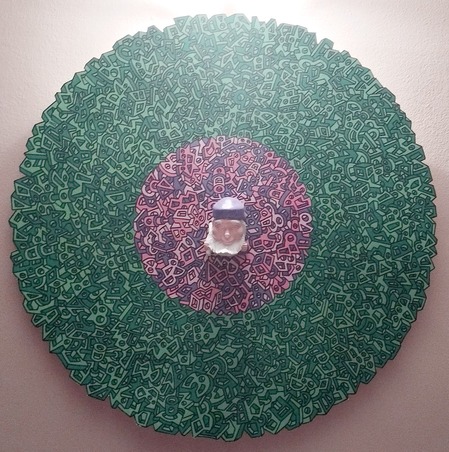
Questa caratteristica espressiva è la base di ciascuna delle sue opere e ha la particolarità di essere realizzata con pennarelli su supporti diversi, dalla tela alla ceramica, perché i limiti della bidimensionalità sono stretti per Byro, il quale ha bisogno di sperimentare e sovrapporre gli strati della materia per dare vita a opere che tendono verso lo spazio intorno a sé. Ma il suo spirito Pop si svela nell’ironia con cui osserva la realtà che lo circonda, l’evoluzione della società, le sue nuove regole spesso persino contro quei valori del passato considerati ormai arcaici ma che restano parte della cultura di una generazione di passaggio tra il vecchio e il nuovo;
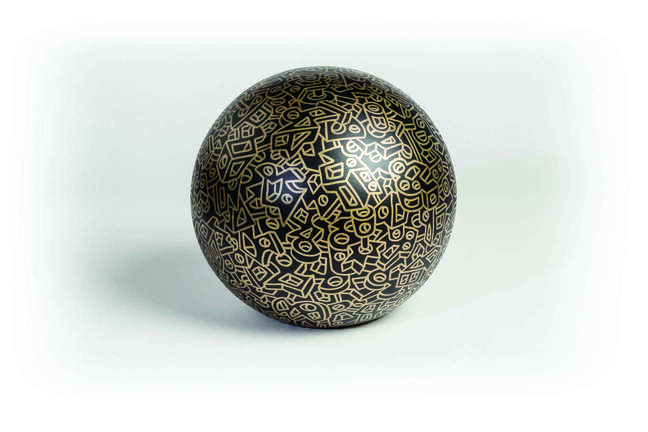
davanti a questi cambiamenti l’atteggiamento dell’artista è quello dell’apertura, pur mantenendo una posizione di dubbio, di perplessità, lasciando emergere tutto ciò che appartiene alla modernità in maniera divertita, irriverente e al tempo stesso consapevole che fa e farà inevitabilmente parte di un inedito modo di concepire il mondo intorno a sé. In alcuni casi le sue sembrano essere denunce, modi artistici per porre in evidenza alcune realtà sociali troppo spesso trascurate dai potenti della terra che però dimenticano di considerare il singolo e le conseguenze che le loro azioni provocano, come nell’opera Aleppo,
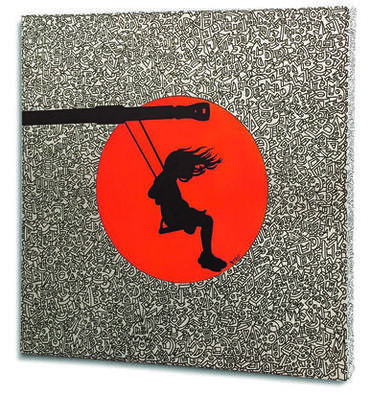
in qualche modo vicina alle denunce Street Art di Banksy, dove una bambina siede su un’altalena appesa a un cannone; è evidente la posizione di Byro nei confronti della guerra, dei bombardamenti apparentemente portatori di democrazia che però poi vanno a distruggere il tessuto sociale, a generare sofferenza e devastazioni nelle popolazioni civili, nei bambini che devono perdere la loro innocenza per prendere atto troppo presto delle ingiustizie e della crudeltà dell’essere umano. In questa tela il pennarello è accompagnato dalla vernice spray per dare un effetto ancora più incisivo all’ombra della bambina che sembra voler compiere un tentativo per recuperare l’infanzia perduta a causa della presenza dei cannoni.
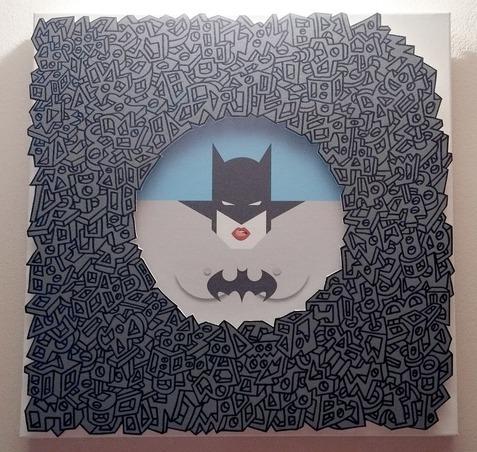
Da grande osservatore della realtà contemporanea Byro non poteva non dedicare spazio anche a quelle aperture della società nei confronti di tutte quelle persone che non si sentono a proprio agio nei panni in cui sono nate e che intraprendono un percorso di cambiamento di genere a loro necessario per assecondare l’aspetto esteriore alla loro natura interiore; ovviamente avendo un forte spirito Pop, ironizzare su questo argomento trasformando gli eroi dei fumetti sembra quasi naturale ed è questo il senso inclusivo delle opere Bat Transvenger e Flash Transvenger, l’opera in copertina articolo, dove i supereroi hanno modificato le loro sembianze e si propongono in modo ammiccante e provocante all’osservatore che non riesce a non sorridere davanti all’inedita immagine che ne dà l’artista. In entrambe queste tele, dove Byro sovrappone due strati di tela, il primo decorato con il suo tradizionale segno grafico, il secondo costituito dalla stampa digitale, pone i due protagonisti al centro del cerchio che può essere ricondotto all’effetto dell’occhio di bue teatrale, mentre intorno danzano le geometrie tridimensionali della molteplicità della realtà, sfaccettature di pensieri e di concetti che sottolineano quante siano le possibilità di idee e di pensiero che appartengono alle differenti individualità.
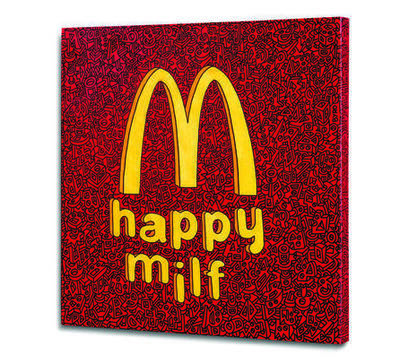
Il lato più burlesco di Byro emerge però nell’opera Happy Milf in cui gioca con l’assonanza in inglese tra uno dei pasti tipici di McDonald’s a una tendenza sdoganata nella contemporaneità ma in fondo esistente da sempre, dei ragazzi giovani attratti da donne mature definite appunto con il termine irriverente del titolo. Approfondendo il concetto della tela, emerge il punto di vista di Byro sulla mistificazione dei rapporti tra le persone, sempre più frequentemente ridotti a un fast sex di cui appunto il fast food diventa metafora; tutto nella società attuale sembra galleggiare in superficie, come se l’individuo non fosse più predisposto a creare dei legami intensi e solidi, forse perché è semplice consumare in fretta qualunque cosa senza dover affrontare le complicazioni di un rapporto più intimo.
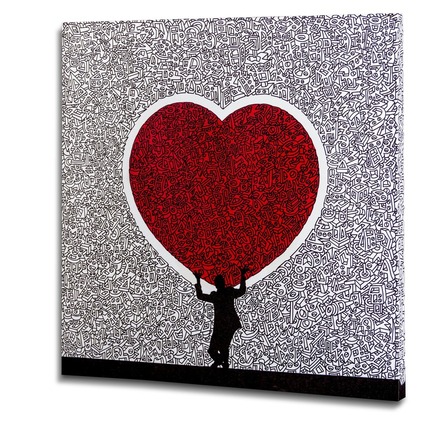
Eppure l’amore fa parte dell’esistenza, appartiene all’essere umano per sua stessa natura, non può e non potrà mai essere superato o messo in secondo piano dalla superficialità e dalla fretta di consumare per dedicarsi ad altro subito dopo, perché alla fine l’uomo ha bisogno di qualcuno accanto; ed è proprio questo che emerge dall’opera Power of Love, dove il personaggio, e in questo caso il riferimento a Keith Haring è evidente anche per il significato espresso, tiene sulle sue spalle un grande cuore, simbolo del peso del sentimento e dell’impegno che richiede una relazione in cui le emozioni siano piene protagoniste, ma anche l’unica in grado di poter regalare gioia e pienezza. Nelle sculture invece Byro affronta la forma sferica o tondeggiante in ceramica a biscotto che decora con il suo segno grafico oppure trasforma in immaginari personaggi di fumetti.
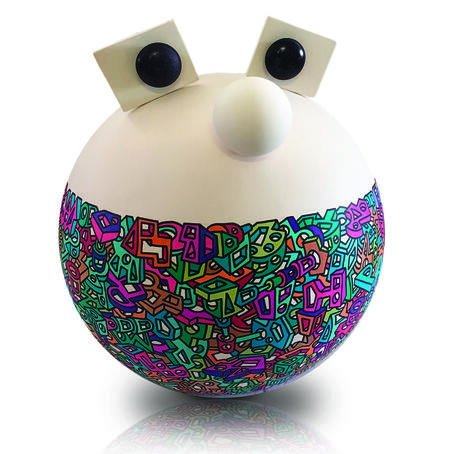
Byro si è formato come grafico designer e ha sempre lavorato in campo pubblicitario creando story board e layout dunque non ha resistito al richiamo dell’arte dando vita al suo singolare stile in virtù del quale ottiene risultati e riconoscimenti partecipando a importanti fiere di arte contemporanea italiane.
BYRO-CONTATTI
Email: byrozu@gmail.com
Sito web: http://www.byrodesign.com
www.balthasart.com (Roberto Zucchi)
Instagram: https://www.instagram.com/byro_art/
Byro’s Graffiti Style, an ironic and shrewd look at contemporary reality
Making fun of oneself while being able to capture both the more playful and the more intense side of today’s society is a characteristic common to few artists, because art is often seen and experienced as a way of letting out all the emotional tensions that the author of an artwork cannot communicate in a different way; however, there have been, and still there are, creative artists who have been able to make their voice heard even without immediately showing their capacity for insight, but rather by attracting the gaze of the observer with an apparently direct and amusing language that only later leads to a more acute reflection of the message that the artist wished to leave behind. Today’s protagonist chooses a singular and personal stylistic style through which he explores everything that belongs to the contemporary world.
After having broken all the moulds of traditional art, after having explored the mind and the unconscious, after having first lost and then regained contact with emotion, the artists of the mid-1950s, especially those from the United States, began to feel the need to find a new language that would be more akin to and comprehensible to the new emerging middle class, which, although it had no specific cultural training to develop a sensitivity towards art, did have the economic capacity to be able to purchase artworks, even if not of the highest value. This was the moment when Pop Art was born, guided by the incredible intuition of Andy Warhol, who transformed common consumer goods into art, as well as the images of cinema and politics that were part of most people’s everyday life; painting completely changed its appearance, prints, silk-screen printing, the graphic sign, became an integral part of the expressive language of Roy Liechtenstein, Tom Wesselmann and Keith Haring‘s incursions into Street Art. The immediacy of their images, their expressive simplicity could conquer in a direct way precisely that middle class that was beginning to acquire relevance in society and above all needed to recognise itself in the objects, and consequently the pieces of art, that they chose to have in their homes. Finding familiar symbols, letting people fall in love with an easy-to-understand image that did not require too much intellectual training was the winning formula for that generation of artists who were able to write a new page in modern art. Where Roy Liechtenstein linked himself to the world of comic strips, showing how graphics, even if executed in oil on canvas, could have an interesting impact on reaching the viewer and how the onomatopoeic sound of cartoon strips gave an ironic touch, Tom Wesselmann chose irreverence towards the art of the past, the daily habits of the present and the new and old weaknesses of man and woman, mixing painting and sculpture to instil a sense of bizarre reality. And finally, Keith Haring, the true genius of the graphic line through his Radiant Boys that created a sort of human grid with which the artist represented reality, raising awareness and denouncing the discomforts and difficulties of a homosexuality that was still not fully accepted. The artist Lombard by origin but Romagna by adoption Roberto Zucchi, aka Byro, is inspired by Haring‘s graphic grids, which in his case, however, do not represent a stylisation of man, but rather describe geometric figures or letters that have other geometric figures or letters inside them, almost as if to suggest the infinite possibilities and combinations that undeniably belong to the polyhedral nature of reality. This expressive characteristic is the basis of each of his artworks and has the peculiarity of being realised with felt-tip pens on different supports, from canvas to ceramics, because the limits of two-dimensionality are narrow for Byro, who needs to experiment and superimpose the layers of matter to give life to works that tend towards the space around him. But his Pop spirit is revealed in the irony with which he observes the reality that surrounds him, the evolution of society, its new rules often even going against those values of the past that are now considered archaic but remain part of the culture of a generation of transition between the old and the new; in the face of these changes, the artist’s attitude is that of openness, while maintaining a position of doubt, of perplexity, allowing everything that belongs to modernity to emerge in an amused, irreverent manner, and at the same time aware that it is and will inevitably be part of an unprecedented way of conceiving the world around him. In some cases, his paintings seem to be denunciations, artistic ways of highlighting certain social realities that are all too often overlooked by the powerful of the earth who, however, forget to consider the individual and the consequences that their actions provoke, as in the work Aleppo, somewhat close to Banksy‘s Street Art denunciations, where a little girl sits on a swing hanging from a cannon; Byro‘s stance on war, on bombings that seem to bring democracy but then go on to destroy the social fabric, to generate suffering and devastation in civilian populations, in children who have to lose their innocence in order to realise all too soon the injustice and cruelty of human beings. In this canvas, the marker is accompanied by spray paint to give an even more incisive effect to the shadow of the little girl who seems to want to make an attempt to recover her childhood lost to the presence of the cannons. As a great observer of contemporary reality, Byro could not fail to dedicate space also to those openings of society towards all those people who do not feel comfortable in the shoes they were born into and who undertake a path of gender change necessary for them to match their outward appearance to their inner nature; obviously having a strong Pop spirit, ironising on this subject by transforming comic book heroes seems almost natural, and this is the inclusive sense of the paintings Bat Transvenger and Flash Transvenger, the work on the article cover, where the superheroes have changed their appearance and present themselves in a winking and provocative way to the observer who cannot help but smile at the unprecedented image the artist gives them. In both of these canvases, where Byro superimposes two layers of canvas, the first decorated with his traditional graphic sign, the second made up of a digital print, he places the two protagonists in the centre of the circle that can be traced back to the effect of a theatrical bull’s eye, while all around dance the three-dimensional geometries of the multiplicity of reality, facets of thoughts and concepts that emphasise how many possibilities of ideas and thought belong to different individualities. Byro‘s more burlesque side emerges, however, in the work Happy Milf in which he plays with the assonance in English between one of the typical McDonald’s meals and a trend that is now customs-cleared in contemporary times but has always existed, of young boys attracted to mature women defined precisely by the irreverent term of the title. Delving deeper into the concept of the canvas, emerges Byro‘s point of view on the mystification of relationships between people, increasingly reduced to a fast sex of which fast food becomes a metaphor; everything in today’s society seems to float on the surface, as if the individual is no longer predisposed to create intense and solid bonds, perhaps because it is easy to consume anything quickly without having to face the complications of a more intimate relationship. Yet love is part of existence, it belongs to the human being by its very nature, it cannot and will never be overtaken or sidelined by superficiality and the haste to consume in order to devote oneself to something else immediately afterwards, because in the end man needs someone beside him; and it is precisely this that emerges from the artwork Power of Love where the character, and in this case the reference to Keith Haring is also evident in the meaning expressed, holds a large heart on his shoulders, a symbol of the weight of feeling and the commitment that requires a relationship in which emotions are the full protagonist, but also the only one that can give joy and fullness. In his sculptures, Byro instead tackles the spherical or roundish ceramic biscuit shape that he decorates with his graphic sign or transforms into imaginary cartoon characters. Byro trained as a graphic designer and has always worked in the field of advertising, creating storyboards and layouts, so he has not resisted the call of art, giving life to his unique style, by virtue of which he obtains results and recognition by participating in important Italian contemporary art fairs.


